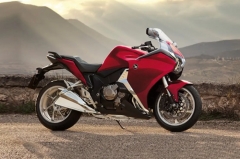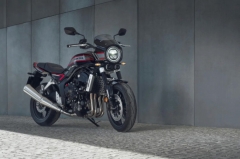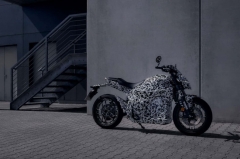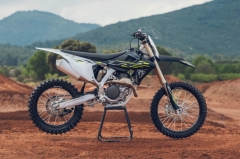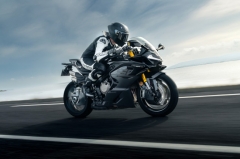Will the Honda CB750 Hornet replace the CB650R?
Would you like Honda’s new twin-cylinder middleweight to replace its four-cylinder middleweight?

The new Honda Hornet was unveiled at Intermot this year, and some sources are claiming that the model will be the successor to the Honda CB650R, which can be good news or bad news depending on how you look at it. There are no definite statements yet, but because some sources are saying that the CB750 Hornet will be the successor to the CB650R, it has us a little worried.
There is no clear answer for now as to the fate of the beloved CB650R, and Honda has made no official statements for now. The CB750 Hornet is remarkably different from the CB650R in that it sort of steps back a generation when the CB650F was the middleweight in the Honda lineup—pre-Neo-Sports Cafe bikes. It’s a bit of a step in the other design direction if you ask us.
As for the line of succession, some news sources and internet speculators are wondering whether the CB650R will get discontinued. On the one hand, it seems likely, on the other, it’ll be hard to let the model go. Again, Honda hasn’t officially stated anything so the CB650R’s fate still is up in the air.
Why the CB650R will have to go

There are a bunch of reasons why the CB750 is a viable candidate to replace the CB650R, whether we like it or not. The first will be price since the CB650R does quite a number on Honda’s production costs mainly because of that four-cylinder engine. When it was first launched in other countries like the UK, the price hit about £10,000 GPB, or the then equivalent of about P600,000. Of course, the Philippines’ launch price was just a hair over P500,000 since we get our CB650R units from Thailand. However, the price announced at Intermot was in the region of £6,999 GBP, or almost $8,000 USD. That’s the equivalent of about P400,000 Philippine Pesos.
The Hornet is also sporting a twin-cylinder engine with a lot of torque down low and a decent peak figure up top at 90 hp. The motor is a 755cc liquid-cooled, eight-valve, parallel twin with a 270-degree firing order that punches out about 75 Nm of torque at 7,250 RPM. The engine is mated to a six-speed gearbox and it has an alleged top speed of 205 km/h. The 650R is also on an older engine platform which means that emissions standards throughout the world could be pushing the four-cylinder motorcycle out of several markets. The CB750’s engine, meanwhile, is newer and meets current emissions standards in Europe.

Another marked advantage of leaving the inline-four is the weight. The CB650R came in at a rather massive 202 kg, while the Hornet weighs 190 kilograms. That’s about 12 kilos lighter than the CB, which is not a lot considering that two cylinders were taken out of the mix. However, the Hornet is lower to the ground because it has a seat height of 795mm in comparison to the CB650R’s 810mm. To add insult to injury, Honda themselves have even compared the CB650 to the CB750 stating that “The Hornet’s steel diamond frame is lightweight, at just 16.6kg (for comparison, the CB650R’s is 18.5kg).” Now, that’s not definitive but why is Honda comparing the 650R to the CB750?
In summary, the Hornet gets a torque boost over the CB650R, about as much power, a lighter curb weight, and a lower seat height which helps a lot with approachability. It’s also speculatively cheaper to manufacture with only two cylinders under-tank, and did we mention that it has a better electronics package? Not yet?

Well, the CB650R is rather bare-bones in today’s market of middleweight naked bikes. It only gets basic traction control and dual-channel ABS as standard for the Philippines, but the Hornet adds to that with Honda’s throttle-by-wire system, Standard, Sport, Rain, and User riding modes, Honda Selectable Torque Control (traction control), and even wheelie control level options. Riders can interact with the Hornet through a full TFT display which includes a shift indicator, gear position indicator, a tachometer, and also a speedometer among other functions. There is even a Honda Smartphone Voice Control system which is compatible with Android and Apple devices. Then finally, we have auto-canceling turn signals. The Hornet will be a big leap forward for Japanese middleweight naked bikes, and its tech package is comparable to that of the Triumph Trident 660, one of Hinckley’s best sellers currently.
The last reason why Honda could make the CB750 Hornet a successor to the CB650R is because it’s facing stiff competition from other middleweight parallel twins from the likes of Yamaha, KTM, and even a new SV650 from Suzuki (yes, even Suzuki is moving away from its historic V-Twin platform). Honda might be doing the same thing given that the CB650R’s engine is quite old at this point, with a cable throttle, basic traction control, and a power figure that is just okay for a modern four-cylinder. On top of all of this, it is cheaper and more tech-laden which means that it could present an even better value proposition for the feature-hungry bargain hunters in the world of big bikes.
Why the CB650R could stay

So after rifling off all of the reasons why the CB650R might get discontinued, it could be that Honda is simply adding another CB to the family and it will keep the 650R in the lineup given how beloved the model is. The scream of an inline four is something else, and Honda’s one of the only manufacturers now that offer an inline four in a middleweight naked bike, which makes it a great differentiator in a segment that is populated by twins. The only other way you can get a Japanese inline-four in the middleweight is by going with a Kawasaki Z900 or the Suzuki GSXS-750, but some people will prefer a smaller displacement altogether and the Suzuki is rather dated at this point.
On top of that, the Neo-Retro-Sports-Cafe styling is something that Honda has pioneered and hasn’t carried over to the Hornet. It seems quite sad to see that Honda could be dropping the design language, but will they? Hopefully, Honda won’t.

Some were even lambasting the Hornet because it didn’t get the Neo-Retro styling that Honda is known for because of the CB1000R and the CB650R. Yes, we get it the Honda Hornet should look a little more insect-like, but that hasn’t stopped a few enthusiasts from imagining what the Hornet would look like with the CB650R’s headlight. In all honesty, the Hornet’s design isn’t particularly inspiring, but its tech is rather impressive.
So will it?

It remains to be seen whether Honda will treat the CB650R like how Yamaha treated the R6. Hopefully, the CB650R gets another update rather than getting a farewell party. The Hornet looks like a decent contender in the middleweight segment offering loads of torque and some rather beefy power figures to boot. If Honda were to push through with discontinuing the CB650R, then that would mean that only the CB1000R will be the only naked bike in the Honda lineup with an inline-four, locking out that engine configuration to the premium end of the market.
While we don’t know if the CB650R will still be able to meet emissions standards, it seems like a bit of a waste to see it go by the wayside. Perhaps Honda doesn’t have time anymore to develop another middleweight inline-four engine given that many buyers are also excited about the NC750, Transalp, and the purported middleweight Africa Twin.

Still, Honda hasn’t made any announcements yet so fingers crossed that we’ll see the new CB750 Hornet and the CB650R both in the same lineup still.
Tagged Under
Related Articles
-
Honda files patents for new V4 engine / News
Recent patents suggest that Honda is working on a new V4 engine.
-
Take a look at the new Honda CB1000F / News
Honda has revealed the production-spec CB1000F, blending retro style with Hornet-based performance and modern tech. Expected to hit UK showrooms in early 2026.
-
Honda teases its first full-size electric motorcycle / News
Honda has teased its first ever performance-focused electric motorcycle called the EV Fun Concept.
-
Honda Navi commuter officially launched in the Philippines / News
Honda has officially launched the Navi in the Philippines, with an SRP of P58,900 and P3,000 off until August 31, 2025.
-
Honda launches E-VO electric motorcycle exclusive to China, for now / News
Honda has pulled the covers off the E-VO, a fully electric futuristic motorcycle in the Chinese market.
Latest News
-
Hero MotoCorp says more small-displacement Harley-Davidsons are coming soon / News
Hero MotoCorp has confirmed that it will be working on more 440cc models for Harley-Davidson, following the success of the X440.
-
Triumph’s TF 450-X is the ultimate motocross machine / News
Triumph enters the 450 motocross class with the TF 450-X, offering premium components, smart updates, and advanced rider aids out of the box.
-
CFMOTO's new 750SR-S sportbike launched in international market / News
CFMOTO has unveiled the 750 SR-S in the global market, hinting at a potential launch in the Philippines in the near future.


